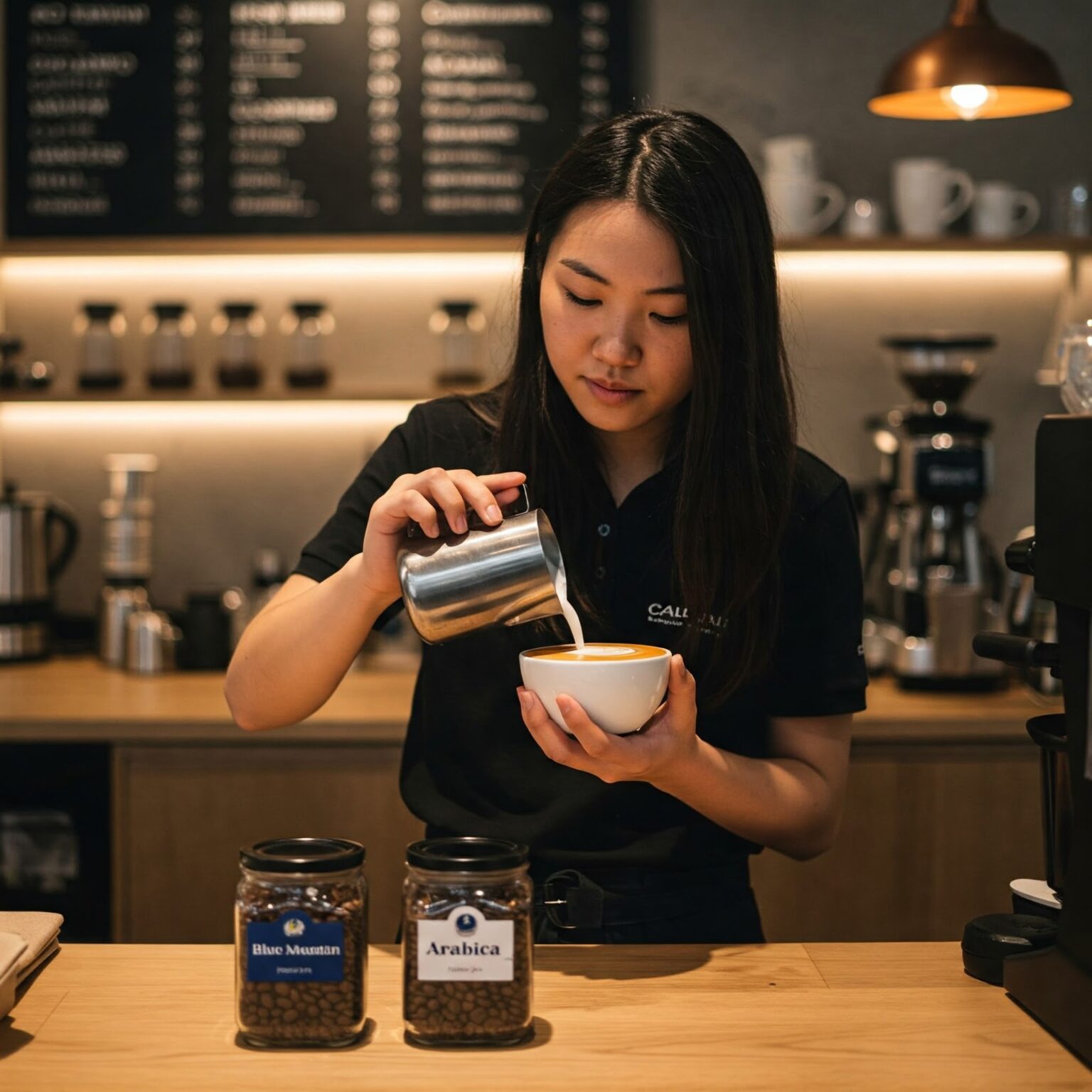How SOE Single Origin Espresso Transforms Your Wake-Up Brew
How SOE Single Origin Espresso Transforms Your Wake-Up Brew
Blog Article
Discovering the Abundant Tastes of Coffee Beans: a Deep Study Espresso and Blended Coffee Beans
When you explore the rich tastes of coffee beans, you reveal a complex world where each range brings its own personality to your mug. As you navigate via the art of coffee and the imagination behind blended coffees, you'll start to appreciate the nuances that make each sip unique.
The Beginnings of Coffee Beans: Exploring Terroir and Flavor Profiles
When you take a sip of coffee, you're not simply enjoying a drink; you're experiencing an abundant tapestry of tastes formed by the beans' beginnings. Each area creates one-of-a-kind taste accounts affected by environment, soil, and altitude. Beans from Ethiopia typically burst with intense, fruity notes, while those from Colombia tend to provide a well balanced, nutty sweetness.
As you discover various beginnings, you'll see exactly how terroir-- the environmental variables influencing a plant-- plays an important duty - Single Origin Espresso. The very same coffee selection can taste significantly various depending on where it's grown
When you think about these variables, you start to appreciate the intricacy behind your mug. Each sip narrates of the land and the farmers that nurtured the beans. So, following time you indulge, think of the journey your coffee took before it reached your hands, and appreciate those elaborate flavors that reflect its beginning.
Recognizing Coffee: The Art and Science Behind the Brew
When you believe about espresso, it's not almost the solid flavor; it's additionally about the methods that bring it to life. Understanding exactly how various preparation techniques impact taste can transform your developing experience. Allow's discover the ins and outs of espresso prep work and discover the distinct taste accounts that make each cup special.
Espresso Preparation Techniques
Coffee preparation is both a science and an art, incorporating precise methods with a deep understanding of coffee. To begin, you'll wish to select premium, freshly baked beans and grind them finely for excellent removal (Single Origin Espresso). The grind size is essential; also rugged, and your espresso will be weak, too fine, and it'll be bitter
Following, tamp the grounds equally in the portafilter to assure uniform extraction. When you secure it into the machine, go for a developing temperature in between 190 ° F and 205 °
F.As you pull the shot, look for the excellent removal time-- around 25-30 secs. The result must be an abundant, velvety espresso with an attractive layer of crema on top. With method, you'll understand these techniques.
Taste Profiles Explained
The world of coffee offers a rich tapestry of taste accounts that can elevate your coffee experience. You'll observe an equilibrium of sweetness, acidity, and anger when you take that first sip. Each coffee bean brings distinct notes, from fruity and floral to nutty and chocolaty. Light roasts commonly showcase brilliant level of acidity and lively tastes, while dark roasts existing much deeper, bolder tones.
Understanding these accounts assists you choose the appropriate espresso for your taste. Trying out various blends can reveal unusual mixes. A well-crafted mix might harmonize the bright notes of an Ethiopian bean with the rich, chocolatey touches of a Brazilian bean. Welcome the journey of uncovering coffee's varied tastes, and you'll change your coffee ritual right into an exciting experience.
Handling Approaches: How They Impact Taste and Scent
While it may appear that the beginning of coffee beans is the most significant consider determining their taste and aroma, the processing approaches used post-harvest play an equally vital function. You'll locate that these methods can dramatically modify the final taste account of your mug.
For example, the washed process removes the fruit from the beans prior to fermentation, often leading to a cleaner, brighter flavor. The natural procedure leaves the fruit undamaged during drying out, resulting in a sweeter, fruitier profile.
Other techniques, like honey processing, strike a balance, permitting some fruit mucilage to continue to be, providing a special complexity.
Each handling technique engages with the beans' intrinsic attributes, boosting or muting specific tastes and aromas. So, when you drink that coffee or combined coffee, bear in mind that the journey from cherry to mug is affected not simply by origin yet additionally by just how those beans were processed.
Toasting Methods: Opening the Full Potential of Coffee Beans
Roasting techniques are essential for revealing the complete possibility of coffee beans, as they change raw, green beans into the fragrant, savory coffee you appreciate. The selection of roasting approach-- light, medium, or dark-- dramatically affects flavor profiles.
A slower roast at reduced temperature levels permits for complicated tastes to develop, while a quicker roast can heighten anger. By understanding these techniques, you'll disclose a world of flavor, raising your coffee experience to new elevations.
The Magic of Blended Coffee: Producing Distinct Taste Experiences
Creating a special taste experience with mixed coffee can transform your early morning ritual right into an expedition of preference. By integrating different beans from different areas, you can reveal a symphony of flavors that elevate your mug to new heights. Each mix deals a distinct account, stabilizing acidity, body, and sweet taste to produce something really special.
When you select a blend, you're not simply choosing a coffee; you're selecting a trip throughout diverse landscapes and societies. Try out different combinations enables you to discover your personal faves, whether you appreciate fruity notes or rich, chocolatey touches.

Sampling Notes: Recognizing the Subtleties in Your Mug
As you drink your coffee, you could see a range of tastes dancing on your palate, each revealing the complexities of the beans. You might taste the bright level of acidity evocative citrus or the deep, rich notes similar to dark chocolate. The sweetness could evoke honey or caramel, stabilizing the overall account magnificently.
Take notice of the body of the coffee-- does it really feel airy and light, or is it full and creamy? The coating, as well, uses hints; a remaining aftertaste may hint at nuttiness or floral undertones.

Do not fail to remember to explore the distinct features of various origins, as each region gives distinctive tastes - Single Origin Espresso. Ethiopian coffees often existing fruity notes, while Colombian beans could showcase a more spherical sweetness. By recognizing these nuances, you'll deepen your gratitude for each mug, boosting your coffee experience to new elevations

Brewing Methods: Optimizing Taste Removal for Every Bean
When you discover the numerous brewing methods, you'll discover that each technique can substantially affect the taste account of your coffee. From French press to pour-over, each method essences various compounds, improving or silencing details notes. For example, using a French press permits oils to continue to be in the brew, developing a richer taste, while pour-over highlights clarity and illumination.
Temperature and grind dimension also play vital roles. A coarser grind functions best for cool brews, while a great grind is suitable for coffee. Experimenting with water temperature-- between 195 ° F and 205 ° F-- can expose covert flavors, as well.
Do not ignore steeping time; a quick extraction can bring about sour notes, while over-extraction may yield anger. By readjusting these variables, you can take full advantage of flavor removal and really boost your coffee experience. Appreciate the journey of uncovering what method finest suits your palate!
Regularly Asked Questions
What Is the Ideal Water Temperature Level for Brewing Coffee?
The optimal water temperature for brewing coffee's between 195 ° F and 205 ° F. If you use water that's too hot, you'll over-extract tastes; too cool, and you won't remove enough. Go for that sweet area for the very best mixture!
How Does Grind Dimension Impact Coffee Taste?
Grind size substantially affects coffee taste. Finer grinds extract extra flavors and oils, leading to a bolder preference, while coarser grinds yield a lighter flavor. Adjusting work size assists you accomplish your preferred coffee profile.
Exist Health And Wellness Conveniences Surrounding Drinking Coffee?

What Is the Distinction Between Arabica and Robusta Beans?
Arabica beans are smoother and sweeter, typically including fruity tastes, while robusta beans are stronger with a bitter preference and greater high levels of caffeine material. You'll observe these distinctions in aroma and developing experience.
Just How Can I Shop Coffee Beans for Freshness?
To store coffee beans for freshness, keep them in an impermeable container, far from warm, wetness, and light. If you just grind what you require right prior to brewing., you'll keep their taste longer.
Discovering the Abundant Tastes of Coffee Beans: a Deep Dive Into Espresso and Blended Coffee Beans.
When you check out the rich flavors of coffee beans, you uncover a complex globe where each selection brings its very own personality to your cup.When you take a sip of coffee, you're not just appreciating a drink; you're experiencing an abundant tapestry of tastes shaped by the beans' origins.Roasting strategies are crucial for exposing the full possibility of coffee beans, as they transform raw, eco-friendly beans right into the fragrant, flavorful coffee you enjoy.As you drink your coffee, you might notice a range of flavors dancing on your palate, each revealing the details of the beans.
Report this page